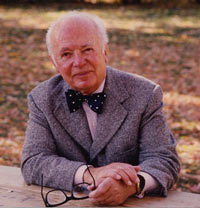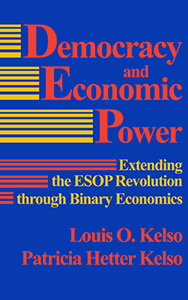What are the financing tools of binary economics?
 ESOP: Employee Stock Ownership Plan. The ESOP is designed to build capital ownership into employees of a business in the course of efficiently financing its growth or other worthwhile corporate objectives, without touching employee paychecks or savings. As to employees, the ESOP is that constitutionally-mandated missing link that gives them access to credit to buy the employer’s capital stock and, without personal risk or liability, to pay for it from the pre-tax earnings of the assets underlying that stock. In other words, equalizing their access to capital credit with that of the already rich.
ESOP: Employee Stock Ownership Plan. The ESOP is designed to build capital ownership into employees of a business in the course of efficiently financing its growth or other worthwhile corporate objectives, without touching employee paychecks or savings. As to employees, the ESOP is that constitutionally-mandated missing link that gives them access to credit to buy the employer’s capital stock and, without personal risk or liability, to pay for it from the pre-tax earnings of the assets underlying that stock. In other words, equalizing their access to capital credit with that of the already rich.
MUCOP: Mutual Capital Ownership Plan. This financing method is intended to provide pooled ESOP financing for a number of corporations while building diversified portfolios of their stocks individually for their employees.
CSOP: Consumer Stock Ownership Plan. This technique is intended for use by public utilities, banks, insurance companies, and other businesses where long-term relationships between the producer and its customers are the rule. Through the intelligent use of credit, it builds capital ownership for customers while providing unlimited low-cost financing for growth of the corporation, thus raising the power of the consumers to pay for their purchases of goods and services while raising the power of the corporation to produce goods and services. It would normally be used in conjunction with an ESOP for employees.
GSOP: General Stock Ownership Plan. The GSOP is designed to build capital ownership into politically designated classes of consumers within the jurisdiction of the authorizing government state, local or federal.
ICOP: Individual Capital Ownership Plan. A financing device intended to create viable capital estates for selected categories of individuals while opening broad markets for equity financing by corporations.
RECOP: Residential Capital Ownership Plan. This financing plan, in combination with commercially insured credit financing, would enable home buyers to purchase homes at less than 25 percent of the out-of-pocket principal and interest cost of similar transactions today, by having their acquisitions treated by tax and other relevant laws as capital assets, rather than as consumer items as at present
COMCOP: Commercial Capital Ownership Plan. Ownership of rental structures, such as office and apartment buildings, factories, mines, railroads, hotels, resorts, etc., is a major source of capital cash income. Today such structures and real estate generally are owned by the excessively wealthy (whose resulting income is thereby sterilized for purposes of the consumer economy and denied to those who could use it if the financing had been COMCOP structured), who use such acquisitions not only to satisfy their antisocial greed, but to wipe out their income taxes. COMCOP would enable commercial structure ownership legitimately to be spread over large numbers of people where it can raise their power to produce the incomes they need to make them powerful and self-supporting consumers, maintain their lifestyles, and to diversify their holdings in businesses in which they become employed as capital workers.
PUBCOP: Public Capital Ownership Plan. This plan is designed to provide low-cost financing for capital instruments used by public bodies of all types — office buildings, streets and sidewalks, parks, street lighting, schools, universities, subways, waterworks, harbors, etc. It permits broad individual ownership, through facilities corporations, by great numbers of people, while providing low-cost capital facilities to be leased at market rates to cities and other municipal corporations, states, the federal government, and other public bodies. PUBCOP is another tool in the arsenal of binary economics to assure that each individual can become employed as a capital worker and that governments do not acquire economic power that should be diffused throughout the citizenry. PUBCOP financing would employ the dual functions of binary financing devices. It would be a major means of eliminating the cost of wasteful, inefficient, and inadequate public employee pensions while providing much greater economic security and incomes, both before and after retirement, to public employees and others.
All of these plans are discussed and diagramed in more detail in Democracy and Economic Power: Extending the ESOP Revolution through Binary Economics.

